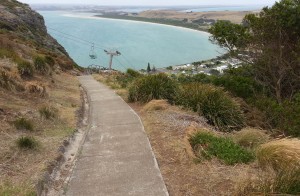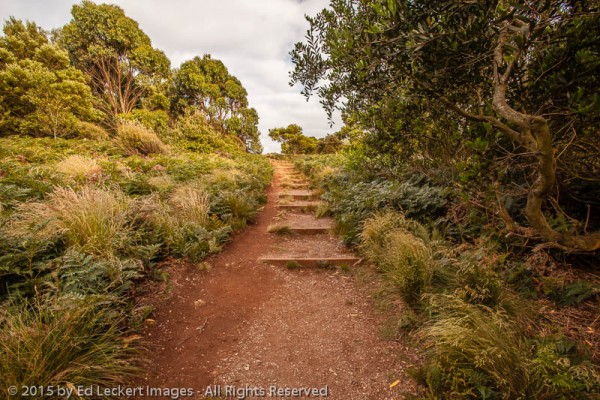


No visit to Tasmania would be complete without a visit to “The Nut”. No, I’m not talking about one of Australia’s candidates for Prime Minister, although it does have a connection to a former British Prime Minister. Actually, the nut I’m talking about an old volcanic plug that totally dominates the landscape around Stanley, Tasmania. But first we have to get to Stanley.
In last week’s article we visited Cradle Mountain-Lake St Clair National Park, and were on our way to Stanley.
The town of Stanley was named after Lord Stanley, the British Secretary of State for War and the Colonies in the 1830s and 1840s, who later had three terms of office as British Prime Minister. There’s your connection between The Nut and the British Prime Minister – a bit of a stretch, I know.
Anyway, before arriving in the town itself I had checked out a couple of campsites nearby, but they were less than appealing, so I decided to splurge on a hotel room that night. This was one of those cases where the economy of a free campsite was outweighed by the convenience of a hotel room, which was much closer to where I wanted to be for my dawn hike and photo shoot. So I booked the last room at the Stanley Hotel, in a very old but attractive building in the heart of town, and just under The Nut. Reception had closed at 5:00 PM, so I checked in with the bartender in the restaurant – a first for me.
Now the hotel has an interesting history as it turns out. We haven’t talked about Tasmania as a penal colony yet (don’t worry, we will!), but here’s a snippet from the hotel’s website to give you an idea of what’s to come.
John Whitbread was found guilty of poaching rabbits in England when he was just a boy aged 15, and was sentenced to seven years in Van Diemen’s Land. He arrived in Hobart in 1828. As a convict his record was of good behaviour and when he later settled in Stanley he became a fine citizen, business man and host. He built the hotel and named it the Emily Hotel, now known as the Stanley Hotel.
That’s right – a 15 year old boy was sent to the other half of the world for a seven year sentence for poaching rabbits. England was a tough place back then.
You’ll note that Tasmania was originally called Van Diemen’s Land. Strangely enough, it was the Dutch explorer Abel Tasman, the first European to land here, who named the island Anthoonij van Diemenslandt, in honour of Anthony van Diemen, the Governor-General of the Dutch East Indies, who had sent Tasman on his voyage here in 1642. It was only after the island decided to re-brand to distance itself from a cruel past that it became known as Tasmania.
But back to the present. I noticed on the specials menu in the restaurant that a half-Crayfish dinner was only AUD 45.00. Now if you’re from Louisiana like me, you’re thinking:
Well, I’d seen prices much higher than AUD 45.00, so this seemed like a great time to find out what this crayfish thing was all about. Well, it turns out that when an Aussie says “crayfish”, what they really mean is saltwater spiny lobster, which is nothing like an American crawfish, crawdad, mudbug, or whatever you want to call it. Who knew? Anyway, the thing was delicious, a great treat, and well worth the money.

The Zig Zag Track to The Nut appears to go straight down as it passes near the chairlift, in Stanley, Tasmania, Australia.
OK, back to reality. Early the next morning I decided to tackle The Nut. The trail to the relatively flat top seems to go almost straight up the 470 ft (143 m) that it takes to get there. It’s so bad they actually have a chairlift to get the less enthusiastic tourists to the top. And the wind!
The Bass Strait is known for fierce winds and seas that result from the strong currents between the Antarctic-driven southeast portions of the Indian Ocean and the Tasman Sea’s Pacific Ocean. My camera was vibrating violently on its tripod as I photographed the coastal scenes from near the edge, but just a few feet in from the edge it was actually quite calm.
I ran into a few hikers and runners, including one travelling American couple who were out for some early morning exercise. And, of course, the ubiquitous little wallaby thingies known as Tasmanian Pademelon were everywhere, looking for breakfast.
The scenery within the little forest up on The Nut, like the rest of Tasmania, did not disappoint. It was the perfect place to get some exercise, relax, and take in beautiful views – from forest to coastline to wildlife, this little reserve has it all.

Steps on the hiking trail lead through lush green forest at The Nut State Reserve, Tasmania, Australia.
Next week we’ll explore the remote west of Tasmania, and we’ll try not to get stranded in the middle of nowhere!

Another good news letter Ed.
History question – Did the Aboriginal people or the Polynesians make it to Tasmania in its early history before the Europeans ‘discovered’ it?
Love it, Ed!! Thanks for introducing me to this beautiful place. I’m enjoying your stories very much.
Found some history here Ed:
https://en.wikipedia.org/wiki/Tasmania
Max
Beautiful. Fun living vicariously through your travels!